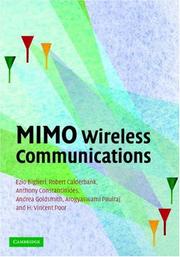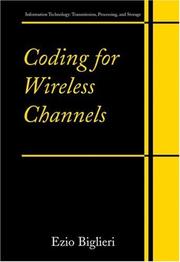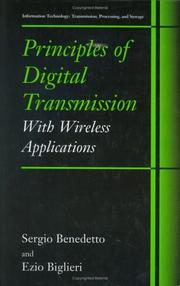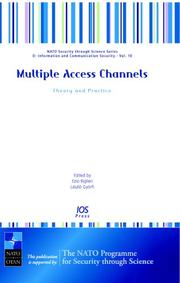| Listing 1 - 10 of 19 | << page >> |
Sort by
|
Book
ISBN: 1402080840 Year: 2005 Publisher: New York, NY : Springer US : Imprint: Springer,
Abstract | Keywords | Export | Availability | Bookmark
 Loading...
Loading...Choose an application
- Reference Manager
- EndNote
- RefWorks (Direct export to RefWorks)
Coding for Wireless Channels is an accessible introduction to the theoretical foundations of modern coding theory, with applications to wireless transmission systems. State-of-the-art coding theory is explained using soft (maximum-likelihood) decoding rather than algebraic decoding. Convolutional codes, trellis-coded modulation, turbo codes, and low-density parity-check (LDPC) codes are also covered, with specific reference to the graphical structures through which they can be described and decoded (trellises and factor graphs). A special section is devoted to multiple-antenna systems and space-time codes. The author assumes that the reader has a firm grasp of the concepts usually presented in senior-level courses on digital communications, information theory, and random processes. Coding for Wireless Channels will serve as an advanced text for undergraduate and graduate level courses & as a reference for professionals in telecommunications.
Coding theory. --- Wireless communication systems. --- Engineering. --- Electrical engineering. --- Communications Engineering, Networks. --- Coding and Information Theory. --- Signal, Image and Speech Processing. --- Electrical Engineering. --- Data compression (Telecommunication) --- Digital electronics --- Information theory --- Machine theory --- Signal theory (Telecommunication) --- Computer programming --- Electric engineering --- Engineering --- Construction --- Industrial arts --- Technology --- Communication systems, Wireless --- Wireless data communication systems --- Wireless information networks --- Wireless telecommunication systems --- Telecommunication systems --- Telecommunication. --- Computer engineering. --- Computers --- Electric communication --- Mass communication --- Telecom --- Telecommunication industry --- Telecommunications --- Communication --- Telecommuting --- Design and construction --- Information theory. --- Signal processing. --- Image processing. --- Speech processing systems. --- Computational linguistics --- Electronic systems --- Modulation theory --- Oral communication --- Speech --- Telecommunication --- Singing voice synthesizers --- Pictorial data processing --- Picture processing --- Processing, Image --- Imaging systems --- Optical data processing --- Processing, Signal --- Information measurement --- Communication theory --- Cybernetics

ISBN: 9780521873284 0521873282 9780511618420 9780521137096 Year: 2007 Publisher: Cambridge Cambridge University Press
Abstract | Keywords | Export | Availability | Bookmark
 Loading...
Loading...Choose an application
- Reference Manager
- EndNote
- RefWorks (Direct export to RefWorks)
MIMO systems --- Systèmes à entrées multiples et à sorties multiples --- 681.3*C21 --- Network architecture and design: networks (centralized, circuit switching, distributed, packet, store and forward); network communications; netword topology --- 681.3*C21 Network architecture and design: networks (centralized, circuit switching, distributed, packet, store and forward); network communications; netword topology --- Systèmes à entrées multiples et à sorties multiples --- Multiple input-multiple output systems --- Wireless communication systems
Book
ISBN: 9780323992763 0323992765 0323992757 9780323992756 Year: 2022 Publisher: London, United Kingdom Academic Press
Abstract | Keywords | Export | Availability | Bookmark
 Loading...
Loading...Choose an application
- Reference Manager
- EndNote
- RefWorks (Direct export to RefWorks)
"Dimensions of Uncertainty in Communication Engineering is a comprehensive and self-contained introduction to the problems of nonaleatory uncertainty and the mathematical tools needed to solve them. The book gathers together tools derived from statistics, information theory, moment theory, interval analysis and probability boxes, dependence bounds, nonadditive measures, and Dempster–Shafer theory. While the book is mainly devoted to communication engineering, the techniques described are also of interest to other application areas, and commonalities to these are often alluded to through a number of references to books and research papers. This is an ideal supplementary book for courses in wireless communications, providing techniques for addressing epistemic uncertainty, as well as an important resource for researchers and industry engineers. Students and researchers in other fields such as statistics, financial mathematics, and transport theory will gain an overview and understanding on these methods relevant to their field. Key Features: Uniquely brings together a variety of tools derived from statistics, information theory, moment theory, interval analysis and probability boxes, dependence bounds, nonadditive measures, and Dempster—Shafer theory. Focuses on the essentials of various, wide-ranging methods with references to journal articles where more detail can be found if required. Includes MIMO-related results throughout."--Provided by publisher.
Uncertainty (Information theory) --- Telecommunication. --- Electrical engineering. --- Computer engineering. --- Computers --- Electric communication --- Mass communication --- Telecom --- Telecommunication industry --- Telecommunications --- Communication --- Information theory --- Telecommuting --- Measure of uncertainty (Information theory) --- Shannon's measure of uncertainty --- System uncertainty --- Information measurement --- Probabilities --- Questions and answers --- Electric engineering --- Engineering --- Design and construction --- Uncertainty (Information theory). --- Telecommunication --- Wireless communication systems --- Mathematics, --- Mathematical models.

ISBN: 1402080832 1402080832 9781402080838 9781402080838 Year: 2005 Publisher: New York: Springer,
Abstract | Keywords | Export | Availability | Bookmark
 Loading...
Loading...Choose an application
- Reference Manager
- EndNote
- RefWorks (Direct export to RefWorks)
Digital
ISBN: 9781402080845 Year: 2005 Publisher: Boston, MA Springer Science+Business Media, Inc
Abstract | Keywords | Export | Availability | Bookmark
 Loading...
Loading...Choose an application
- Reference Manager
- EndNote
- RefWorks (Direct export to RefWorks)
Ergodic theory. Information theory --- Electronics --- Mass communications --- Computer. Automation --- beeldverwerking --- coderen --- informatica --- elektronica --- communicatietechnologie --- informatietheorie --- signaalverwerking
Book
ISBN: 1107237106 1139854275 1139842838 1139845195 1139840452 1139236857 1139846051 1283746670 1139841645 Year: 2013 Publisher: Cambridge : Cambridge University Press,
Abstract | Keywords | Export | Availability | Bookmark
 Loading...
Loading...Choose an application
- Reference Manager
- EndNote
- RefWorks (Direct export to RefWorks)
Widely regarded as one of the most promising emerging technologies for driving the future development of wireless communications, cognitive radio has the potential to mitigate the problem of increasing radio spectrum scarcity through dynamic spectrum allocation. Drawing on fundamental elements of information theory, network theory, propagation, optimisation and signal processing, a team of leading experts present a systematic treatment of the core physical and networking principles of cognitive radio and explore key design considerations for the development of new cognitive radio systems. Containing all the underlying principles you need to develop practical applications in cognitive radio, this book is an essential reference for students, researchers and practitioners alike in the field of wireless communications and signal processing.
Cognitive radio networks. --- Radio frequency allocation. --- Software radio.
Book
ISBN: 1107172217 1280749520 9786610749522 0511260970 0511261543 0511259778 0511309309 1601197527 0511618425 0511260423 Year: 2007 Publisher: Cambridge ; New York : Cambridge University Press,
Abstract | Keywords | Export | Availability | Bookmark
 Loading...
Loading...Choose an application
- Reference Manager
- EndNote
- RefWorks (Direct export to RefWorks)
Multiple-input multiple-output (MIMO) technology constitutes a breakthrough in the design of wireless communications systems, and is already at the core of several wireless standards. Exploiting multipath scattering, MIMO techniques deliver significant performance enhancements in terms of data transmission rate and interference reduction. This 2007 book is a detailed introduction to the analysis and design of MIMO wireless systems. Beginning with an overview of MIMO technology, the authors then examine the fundamental capacity limits of MIMO systems. Transmitter design, including precoding and space-time coding, is then treated in depth, and the book closes with two chapters devoted to receiver design. Written by a team of leading experts, the book blends theoretical analysis with physical insights, and highlights a range of key design challenges. It can be used as a textbook for advanced courses on wireless communications, and will also appeal to researchers and practitioners working on MIMO wireless systems.
Book
ISBN: 9781139236850 9781107028753 Year: 2013 Publisher: Cambridge Cambridge University Press
Abstract | Keywords | Export | Availability | Bookmark
 Loading...
Loading...Choose an application
- Reference Manager
- EndNote
- RefWorks (Direct export to RefWorks)

ISBN: 0306457539 9786610205363 1280205369 0306469618 9780306457531 Year: 1999 Publisher: New York : Kluwer Academic Press,
Abstract | Keywords | Export | Availability | Bookmark
 Loading...
Loading...Choose an application
- Reference Manager
- EndNote
- RefWorks (Direct export to RefWorks)
Principles of Digital Transmission is designed for advanced undergraduate and graduate level students and professions in telecommunications. Teachers and learners can mix and match chapters to create four distinct courses: (1) a one-term basic course in digital communications; (2) a one-term course in advanced digital communications; (3) a one-term course in information theory and coding; (4) a two-term course sequence in digital communications and coding. The book provides rigorous mathematical tools for the analysis and design of digital transmission systems. The authors emphasize methodology in their aim to teach the reader how to do it rather than how it is done. They apply the fundamental tools of the discipline onto a number of systems, such as wireless data transmission systems.
Digital communications. --- Wireless communication systems. --- Digital communications --- Wireless communication systems --- Computer engineering. --- Computer science. --- Engineering. --- Electrical Engineering. --- Computer Science, general. --- Automotive Engineering. --- Electrical engineering. --- Automotive engineering. --- Informatics --- Science --- Electric engineering --- Engineering

ISBN: 6610934800 1280934808 9786610934805 1429492201 160750233X 6000004923 1433708701 9781429492201 9781433708701 9781607502333 1586037285 9781586037284 9781586037284 Year: 2007 Publisher: Amsterdam, Netherlands Washington, DC IOS Press
Abstract | Keywords | Export | Availability | Bookmark
 Loading...
Loading...Choose an application
- Reference Manager
- EndNote
- RefWorks (Direct export to RefWorks)
Surveys general results on multiple-access channels, and gives an overview of the problems of CDMA solutions. This work includes chapters devoted to the information-theoretical aspects of multiple-access communication. It discusses multiple-access techniques and covers coding techniques.
Multiple access protocols (Computer network protocols) --- Computer network protocols. --- Protocols, Computer network --- Computer networks --- MAP (Multiple access protocols) --- Multi-access protocols (Computer network protocols) --- Multiaccess protocols (Computer network protocols) --- Computer network protocols --- Multiplexing
| Listing 1 - 10 of 19 | << page >> |
Sort by
|

 Search
Search Feedback
Feedback About UniCat
About UniCat  Help
Help News
News